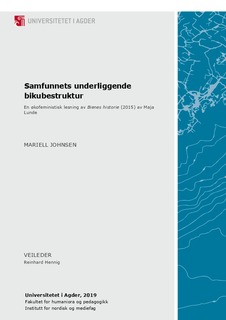| dc.description.abstract | The purpose of thisthesis is to do a close reading and analysis of thenovel Bienes historie(Lunde, 2015) seen in the light of ecofeminist theory. This is an area that has not been explored very much in Norwegian literary criticism. The theoretical part of the thesis is therefore a relatively broad introduction to ecocriticism as a literary study, focusing on theories and subcategories that are especially relevant to this reading. The development and hallmark traits of ecofeminism are central in supporting any observations I make about perspectives on gender and nature throughout my thesis. It is also necessary to elaborate on widespread and central points of view within environmental issues, like anthropocentrism and ecocentrism,to provide an understanding of the characters’ views on non-human nature that are portrayed in the novel. It becomes apparent throughout the reading that the three parts of the novel show a gradual development of the society where the patriarchy starts out as very important but gets less dominant as the years pass. The patriarchy also affects the relationship of caring between humans and other species, and at the same time controls the way humans look at nature. The most prominent view is how the bees are considered worthless by themselves but as a collective they are an important part of nature. There are many examples of anthropocentrism, where humans think of themselves as above nature and other species. Nature is, after a while, more and more affectedby human activity and as a result society turnsdystopian. The only way humans can save themselves is by saving nature and to live with it in harmony. On multiple occasions it becomes apparent that women and care are closely related, especially through motherhood. The mothers in the first two parts are mostly passive, but still are the ones in the family who are understanding and caregiving towards other people. In the third part, Tao is portrayed as an active and strong woman who, at the same time, is acaring mother. The roles within the family are reversed in a lot of ways and so are the roles insociety. Women and care become very important in changing the relations between humans and nature.
86Questions that arose during my analysis are “What role dothe bees play in the novel? Is it really the bees’ story that is being portrayed?”. In many waysthe bees become a cultural tool for humans, in that they represent an important change the humans make within their own society. The bees also become representative of other species and nature in general. The novel never portrays a single bee individually, only collectively as a species. On the other hand,it portrays threeverysubjective stories about three human individuals. What you are really reading aboutis human development through many years, portrayed through the relationship between humans and bees. | nb_NO |

